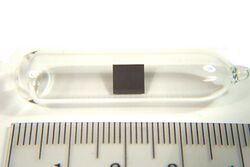Thorium, 90 Thorium Pronunciation (THOR -ee-əm Appearance silvery, often with black tarnish Standard atomic weight A r, std (Th) [1] Thorium in the periodic table
Atomic number (Z ) 90 Group group n/a Period period 7 Block f-block Element category f-block Electron configuration [Rn ] 6d2 7s2 Electrons per shell 2, 8, 18, 32, 18, 10, 2 Physical properties Phase at STP solid Melting point 2023 K (1750 °C, 3182 °F) Boiling point 5061 K (4788 °C, 8650 °F) Density (near r.t. ) 11.7 g/cm3 Heat of fusion 13.81 kJ/mol Heat of vaporization 514 kJ/mol Molar heat capacity 26.230 J/(mol·K) Vapor pressure
P (Pa)
1
10
100
1 k
10 k
100 k
at T (K)
2633
2907
3248
3683
4259
5055
Atomic properties Oxidation states +1, +2, +3, +4 basic oxide) Electronegativity Pauling scale: 1.3 Ionization energies 1st: 587 kJ/mol 2nd: 1110 kJ/mol 3rd: 1930 kJ/mol Atomic radius empirical: 179.8 pm Covalent radius 206±6 pm Spectral lines of thoriumOther properties Natural occurrence primordial Crystal structure face-centered cubic (fcc) Speed of sound thin rod 2490 m/s (at 20 °C) Thermal expansion 11.0 µm/(m·K) (at 25 °C) Thermal conductivity 54.0 W/(m·K) Electrical resistivity 157 nΩ·m (at 0 °C) Magnetic ordering paramagnetic [2] Magnetic susceptibility 132.0·10−6 cm3 /mol (293 K)[3] Young's modulus 79 GPa Shear modulus 31 GPa Bulk modulus 54 GPa Poisson ratio 0.27 Mohs hardness 3.0 Vickers hardness 295–685 MPa Brinell hardness 390–1500 MPa CAS Number 7440-29-1 History Naming after Thor , the Norse god of thunder Discovery Jöns Jakob Berzelius (1829) Main isotopes of thorium
Category: Thorium view · talk · edit references
Th
data m.p. cat
C
1750
—
—
K
2023
2020
3
delta
F
3182
3180
2
delta
max precision
0
WD
input
C: 1750, K: 2023, F: 3182
comment
Th
data b.p. cat
C
4788
—
—
K
5061
5061
0
F
8650
8650
0
max precision
0
WD
input
C: 4788, K: 5061, F: 8650
comment
References These references will appear in the article, but this list appears only on this page.
↑ Meija, Juris; Coplen, Tyler B.; Berglund, Michael; Brand, Willi A.; De Bièvre, Paul; Gröning, Manfred; Holden, Norman E.; Irrgeher, Johanna et al . (2016). "Atomic weights of the elements 2013 (IUPAC Technical Report)". Pure and Applied Chemistry 88 (3): 265–91. doi :10.1515/pac-2015-0305 . ↑ Lide, D. R., ed (2005). "Magnetic susceptibility of the elements and inorganic compounds" . CRC Handbook of Chemistry and Physics (86th ed.). CRC Press. pp. 4-135. ISBN 978-0-8493-0486-6 . https://web.archive.org/web/20110303222309/http://www-d0.fnal.gov/hardware/cal/lvps_info/engineering/elementmagn.pdf . ↑ Weast, R. (1984). CRC, Handbook of Chemistry and Physics . Chemical Rubber Company Publishing. p. E110. ISBN 978-0-8493-0464-4 . Template:Documentation


